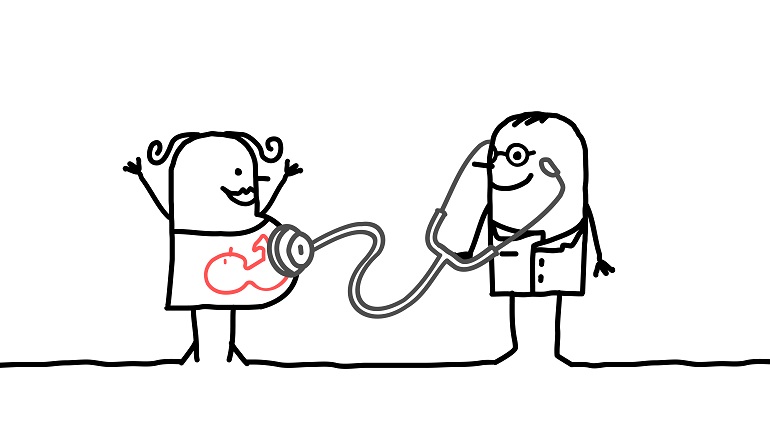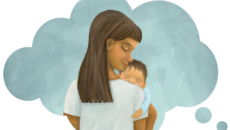“Look at your beautiful, curly hair!” the teacher said to Gillian’s six-year-old daughter, Molly. “It’s so pretty, just like your mommy’s!”
“Thank you,” she said. “Before I was a baby, mommy and daddy had a helper, another mommy, called a donor, and the doctor put me in my mommy’s uterus to grow. And then I came out!”
A look of astonishment flashed across Gillian’s face, and she managed to say, “And Mommy was the happiest mommy in the world! Isn’t that right?” Her daughter nodded and smiled, then buried her face in her mom’s side as sudden shyness took over. Gillian was pleased to see that her daughter was confident about her donor conception story. She sometimes wondered whether she really got it, but this moment proved that she did.
Like Gillian, you should tell your child everything you know about her story. As in traditional adoption, the goal is for the child not to remember being told, because she has always known how she came into your family. Details of sperm, egg, in vitro fertilization, embryos, and cryopreservation can be a lot for young children (and parents, too) to handle. Here’s how to begin talking:
Start Early
The first conversations should begin during infancy, and can be as detailed or as basic as you’d like, because they’re really just practice. Use this time, before your baby can comprehend the meaning of the words, to develop the story that celebrates his beginnings. Explain, in simple terms, how he was created, how the doctor put him inside your uterus to grow. Let him know that you decided to have donor help before he was born: “Daddy’s or Mommy’s body was not able to make a baby. You came to us already made by your genetic parents.” Tell him how thrilled you are at the way things turned out: “We were meant to be your parents. We are so happy that we got help. We have so much to tell you, and we want you to understand your story.”
Follow Your Child’s Lead
If your daughter asks about her preschool teacher who is about to have a baby, answer her questions honestly, and then ask if she wants to hear her own story. Most preschoolers can understand a simple version of their story, such as, “When Mommy and Daddy wanted to have a baby, we couldn’t make one together, so we asked for help. Another person or family gave their genetics [‘baby-making parts’] to the doctor. The doctor put the embryo or sperm into Mommy’s uterus. The embryo started to grow, and it was you! We were very happy when you were born.”
Bring Up the Story from Time to Time
Look for opportunities to reinforce your messages. For example: This is a fire station, where firefighters help people when they are in an emergency. And this is where we went when we needed help for you to come into our family. And this is the hospital where you were born. Showing your child these places provides concrete images and facts.
Use the Correct Words to Tell the Story
Inaccurate words and euphemisms are confusing. If your child asks how embryos are made, you might say, “It takes a part from a man, called a sperm, and a part from a woman, called an ovum, to make an embryo. The embryo grows in a uterus, or a womb.” A young child won’t fully grasp the words right away. She just needs to begin to understand that there are other people to whom she is connected in a significant way.
If You Have a Picture of the Donor or Genetic Family, Share It
You can point out the similarities that genetics create without going into an explanation of DNA. Ask your child if he has any questions about his genetic family. Answer truthfully, even if it means saying, “I wish I knew the answer to that, but I don’t. We can write it down, and maybe we’ll be able to find out someday.”
Read Books that Introduce the Ways that Kids Join Families
Todd Parr has written several books about families and love. The websites hopeandwill.com and XYandMe.com have wonderful stories about donor conceptions—and can help you remind your child that this is how he joined your family.
Create a Lifebook for Your Child, and Read it Often
Sections should include the following: pictures of parents wanting a baby, thoughts on your decision-making, the family or donors who gave their genetics for the child’s life, thoughts on their decision-making, the clinic where you received assistance, waiting for a positive pregnancy test, pictures taken throughout the pregnancy and birth, and pictures of your child coming home. The message is clear: We wanted to have children in our family, we worked hard for our children to arrive, and we accepted and celebrated the help of the many people involved.
As your child realizes the genetic connection he shares with someone else, and not with you, there may be a time of sadness for both of you. Be there for him. Continue to reassure him that you love him, and let him know that it’s OK to be sad. Tell him that you are sad, too, that he is not genetically related to you. Clarify his permanence in your family: “Family is family because they choose to love each other forever. Some families are genetically related and others aren’t.”
The middle school years and beyond will bring new questions, as our kids shift from gathering facts to forming their identity. An honest and trusting relationship, forged in early childhood, will help your child find his roots as he enters adulthood.



